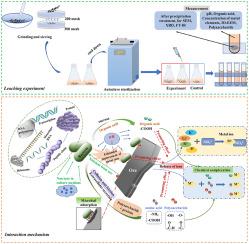Journal of Environmental Management ( IF 8.0 ) Pub Date : 2023-09-30 , DOI: 10.1016/j.jenvman.2023.119082 Xingqing Zhao 1 , Yucheng Zhou 1 , Congcong Ding 1 , Xiaopeng Wang 1 , Xinyi Zhang 1 , Rucheng Wang 2 , Xiancai Lu 2

|
Microorganisms obtain inorganic nutrients or energy from specific minerals to selectively weather minerals, but few studies on the differences in metabolic components of different functional bacteria lead to different weathering effects. This study evaluated the leaching effects of two bacteria with distinct metabolic characteristics on lithium silicate minerals with different structures. We aimed to understand the microscopic mechanism of crystal destruction of lithium silicate minerals with different structures under the action of microorganisms. The results showed that the metabolites produced by an acid producing silicate strain Raoultella sp. Z107 (strain Z107) had a high content of organic acids, among which lactic acid was up to about 11 g/L. Bacillus mucilaginosus 21,699 (strain BM) secreted capsular polysaccharide with a high content of 14.84 mg/L. The metabolic activities of the two strains were significantly different. Through the analysis of the leaching residue, it was found that the lithium silicate minerals were acid etched, interlayer domains expanded, crystallinity decreased, and metal bonds were broken under the action of bacteria. The dissolution of lithium silicate minerals by bacteria is a combination of bacterial adsorption, organic acid corrosion, and complexation of small molecular organic acids and macromolecular polymers with metal ions. The acid erosion and complexation effects of organic acids are greater than the single complexation of capsular polysaccharides, and the layered lepidolite is more likely to be decomposed by the weathering of bacterial metabolites than the chain structure spodumene. These results indicate that the diversity of metabolic activity of bacteria from different sources and the sequence and decomposition mechanism of metal ions released from minerals after lattice destruction are also different. Microorganisms decompose minerals for energy and nutrients, and eventually become the main players in the transformation of elements in biogeology.
中文翻译:

两种具有不同代谢特征的细菌从典型硅酸锂矿石中提取锂:实验、机制和意义
微生物从特定矿物质中获取无机养分或能量来选择性风化矿物质,但很少研究不同功能菌代谢成分的差异导致不同的风化效果。本研究评估了两种具有不同代谢特征的细菌对不同结构的硅酸锂矿物的浸出效果。旨在了解不同结构硅酸锂矿物在微生物作用下晶体破坏的微观机制。结果表明,产酸硅酸盐菌株Raoultella sp. 产生的代谢产物。Z107(菌株Z107)有机酸含量较高,其中乳酸高达11g/L左右。粘液芽孢杆菌21,699(BM株)分泌的荚膜多糖含量高达14.84 mg/L。两种菌株的代谢活性存在显着差异。通过对浸出渣的分析发现,硅酸锂矿物在细菌的作用下受到酸蚀,层间域扩大,结晶度下降,金属键断裂。细菌对硅酸锂矿物的溶解是细菌吸附、有机酸腐蚀以及小分子有机酸和大分子聚合物与金属离子络合的综合作用。有机酸的酸蚀和络合作用比荚膜多糖的单一络合作用更大,层状锂云母比链状结构锂辉石更容易被细菌代谢产物的风化分解。这些结果表明,不同来源的细菌代谢活性存在多样性,矿物晶格破坏后释放金属离子的顺序和分解机制也不同。微生物分解矿物质获取能量和营养物质,最终成为生物地质学中元素转化的主要参与者。








































 京公网安备 11010802027423号
京公网安备 11010802027423号